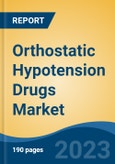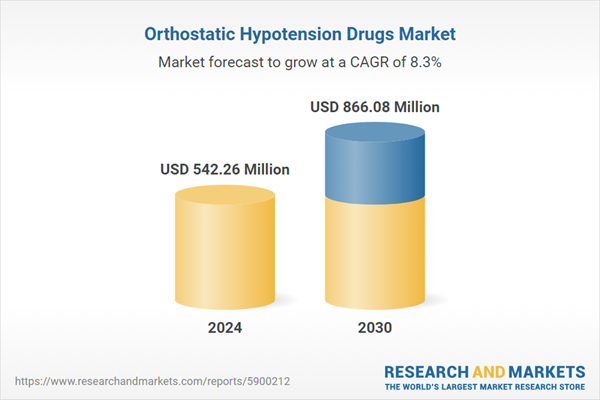Speak directly to the analyst to clarify any post sales queries you may have.
10% Free customizationThis report comes with 10% free customization, enabling you to add data that meets your specific business needs.
Key Market Drivers
Advancements in Medical Diagnostics
Medical diagnostics have seen transformative progress, significantly influencing the management of orthostatic hypotension. Advanced molecular tools such as PCR, next-generation sequencing, and gene profiling now enable precise disease detection and characterization. Liquid biopsies offer a non-invasive method for monitoring disease biomarkers, aiding early diagnosis and treatment response. Additionally, point-of-care devices have become more efficient, providing rapid results critical for conditions like blood pressure abnormalities.Imaging advancements - including MRI, CT, and PET - further improve disease visualization and understanding. Artificial intelligence is increasingly applied to analyze complex datasets, supporting diagnostic accuracy and treatment planning. Omics-based biomarker discovery is fostering new diagnostic tests for cardiovascular and neurodegenerative diseases. Notably, a 2024 statement by the American Heart Association emphasized improved diagnosis and management strategies for orthostatic hypotension in hypertensive patients, highlighting the growing clinical focus on this condition and the need for targeted therapies to enhance patient outcomes
Key Market Challenges
Comorbidities and Complex Patient Profiles
Managing orthostatic hypotension becomes increasingly difficult in patients with multiple coexisting conditions such as diabetes, hypertension, or cardiovascular disease. Many of these individuals are on complex medication regimens, increasing the risk of adverse drug interactions and complicating treatment decisions. Polypharmacy often undermines the effectiveness of orthostatic hypotension drugs and raises safety concerns. Customized treatment approaches are necessary to address each patient's unique health profile, which may demand frequent monitoring and ongoing adjustments to therapy. Additionally, patients with overlapping conditions like neurodegenerative disorders face an elevated risk of falls, requiring holistic care strategies. Understanding the complex interplay between various diseases and their impact on blood pressure regulation is vital to delivering effective and safe treatment solutions.Key Market Trends
Neurogenic Orthostatic Hypotension (nOH) Focus
There is growing clinical and commercial interest in neurogenic orthostatic hypotension (nOH) as a distinct subset of the broader condition. Common in patients with neurological disorders, nOH is increasingly recognized due to improved diagnostic awareness and specialized testing. This subtype, typically involving impaired norepinephrine release, has prompted the development of targeted therapies aimed at improving blood pressure stability.Ongoing clinical trials are evaluating nOH-specific treatments, contributing to a robust pipeline of potential new therapies. Patient advocacy groups and neurological foundations are helping raise awareness and accelerate research in this space. Personalized care strategies are being adopted to address the unique clinical needs of nOH patients. Furthermore, diagnostic advances - such as autonomic function testing - are enhancing accuracy and supporting precision treatment. Pharmaceutical companies are investing in innovative drug classes, including norepinephrine prodrugs and reuptake inhibitors, to meet the specific demands of this growing patient population.
Key Players Profiled in this Orthostatic Hypotension Drugs Market Report
- Mylan N.V.
- Upsher-Smith Laboratories, LLC
- Chelsea Therapeutics International, Ltd
- Amgen Inc.
- F. Hoffmann-La Roche Ltd
- Apotex Inc
- Pfizer Inc.
- Novartis AG
- H. Lundbeck A/S
- Amneal Pharmaceuticals LLC
Report Scope:
In this report, the Global Orthostatic Hypotension Drugs Market has been segmented into the following categories, in addition to the industry trends which have also been detailed below:Orthostatic Hypotension Drugs Market, by Product:
- Droxidopa
- Fludrocortisone
- Indomethacin
- Midodrine Hydrochloride
- NSAIDs
- Pyridostigmine
Orthostatic Hypotension Drugs Market, by Diagnostics Test Type:
- Blood Tests
- ECG
- Echocardiogram
- Stress Test
Orthostatic Hypotension Drugs Market, by End-User:
- Ambulatory Surgical Centers
- Clinics & Hospitals
- Diagnostic Centers
Orthostatic Hypotension Drugs Market, by Region:
- North America
- United States
- Canada
- Mexico
- Asia-Pacific
- China
- India
- South Korea
- Australia
- Japan
- Europe
- Germany
- France
- United Kingdom
- Spain
- Italy
- South America
- Brazil
- Argentina
- Colombia
- Middle East & Africa
- South Africa
- Saudi Arabia
- UAE
Competitive Landscape
Company Profiles: Detailed analysis of the major companies present in the Global Orthostatic Hypotension Drugs Market.Available Customizations:
With the given market data, the publisher offers customizations according to a company's specific needs. The following customization options are available for the report.Company Information
- Detailed analysis and profiling of additional market players (up to five).
This product will be delivered within 1-3 business days.
Table of Contents
Companies Mentioned
The leading companies profiled in this Orthostatic Hypotension Drugs market report include:- Mylan N.V.
- Upsher-Smith Laboratories, LLC
- Chelsea Therapeutics International, Ltd
- Amgen Inc.
- F. Hoffmann-La Roche Ltd
- Apotex Inc
- Pfizer Inc.
- Novartis AG
- H. Lundbeck A/S
- Amneal Pharmaceuticals LLC
Table Information
| Report Attribute | Details |
|---|---|
| No. of Pages | 190 |
| Published | May 2025 |
| Forecast Period | 2024 - 2030 |
| Estimated Market Value ( USD | $ 542.26 Million |
| Forecasted Market Value ( USD | $ 866.08 Million |
| Compound Annual Growth Rate | 8.2% |
| Regions Covered | Global |
| No. of Companies Mentioned | 11 |









